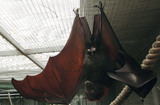Bat Conservation
While many people may be more familiar with the portrayal of Dracula than with actual bats, some facts about these nocturnal creatures may surprise you. For example, not all bats are bloodsucking creatures—only three among the 1,200 species that exist actually consume blood.
Bats, which are the only true flying mammal, rise from the darkness each night to feed on thousands of insects. Their feces also serves as a nitrogen-rich fertilizer, and fruit- and nectar-eating bats help to spread seeds and pollens.
Helping to Conserve Bats
While providing roosting and feeding areas are two essential components for bats, there are other ways you can promote bat conservation.
- Do not disturb bats living in uninhibited buildings, bridges, caves, or mines.
- Add an artificial bat house to your backyard or neighborhood.
- Like a bird bath, having an available source of water in your yard can attract bats.
- Reduce the use of insecticides.
- Increase public awareness about bats—from educating others on why bats are beneficial to providing facts to clear up the false tales associated with bats.
Although bat populations are decreasing throughout Florida, you can help protect them and preserve their habitats. To learn more about the ecological benefits of bats, ways to exclude bat colonies from a building, and more, contact your local Extension office.
Adapted and excerpted from:
H. K. Ober and F. J. Mazzotti, “Conservation of Bats in Florida” (WEC247), UF/IFAS Wildlife Ecology and Conservation Department (rev. 06/2014).

Related Sites & Articles
- Hot Topics
- Bats in Buildings
- UF/IFAS Publications
- Bats of Florida
- Effective Bat Houses for Florida
- Insect Pest Management Services Provided by Bats
- UF/IFAS Videos
- Why Are Bats Important?
- UF/IFAS Sites
- Bat FAQs
- The Bats of the University of Florida Bat House

